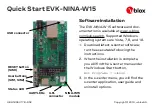
XC886/888CLM
Memory Organization
User’s Manual
3-3
V1.3, 2010-02
Memory Organization, V 1.2
3.1
Compatibility between Flash and ROM devices
Each Flash device consists of P-Flash and D-Flash banks. As shown in
, each
physical D-Flash bank is mapped to two program memory address spaces:
•
D-Flash Bank 0 is mapped to 7000
H
– 7FFF
H
and A000
H
– AFFF
H
•
D-Flash Bank 1 is mapped to 6000
H
– 6FFF
H
and B000
H
– BFFF
H
Figure 3-3
Flash-to-ROM Compatibility
The lower address spaces (6000
H
– 6FFF
H
and 7000
H
– 7FFF
H
) is to be used as program
code, while the higher address spaces (A000
H
– AFFF
H
and B000
H
– BFFF
H
) is to be
used as data. However, if a Flash to ROM device migration is considered, user should
not use the four bytes address space from 7FFC
H
to 7FFF
H
in the Flash device.
For example, if the Flash device is used as a prototype to develop the 32-Kbyte less four
bytes program code (later stored in 32-Kbyte ROM memory) for the ROM device, the two
0000
H
F000
H
C000
H
F600
H
A000
H
P-Flash Banks 0 and 1
2 x 4 Kbytes
Boot ROM
12 Kbytes
XRAM
1.5 Kbytes
24K P-Flash + 8K D-Flash
Device
2000
H
B000
H
4000
H
FFFF
H
P-Flash Banks 2 and 3
2 x 4 Kbytes
P-Flash Banks 4 and 5
2 x 4 Kbytes
6000
H
D-Flash Bank 0 (as data)
4 Kbytes
D-Flash Bank
1
(as program)
4 Kbytes
D-Flash Bank
0
(as program)
4 Kbytes
7000
H
8000
H
0000
H
F000
H
C000
H
F600
H
A000
H
Boot ROM
12 Kbytes
XRAM
1.5 Kbytes
32K ROM Device
B000
H
FFFF
H
D-Flash Bank 0
4 Kbytes
8000
H
ROM
32 Kbytes - 4 bytes
1)
D-Flash Bank 1 (as data)
4 Kbytes
The last four bytes of the ROM in the ROM device from 7FFC
H
to 7FFF
H
are
reserved for the ROM signature and cannot be used for user code or data.
1)
*
















































